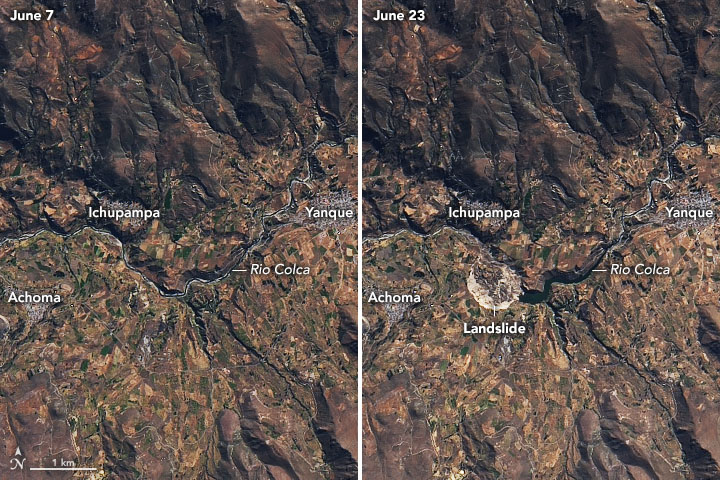


As residents of Peru’s Achoma district slept on June 16, 2020, the earth around them was stirring with activity. At approximately 1:40 a.m., soil and rock on a hillside slipped loose and created a massive landslide. When residents woke up, at least 40 hectares (200 acres) of nearby farmland was destroyed. The landslide also created a natural dam along the Rio Colca and caused flooding in the valley.
The images above show a portion of Colca Valley on June 7 and June 23, 2020, before and after the landslide. The images were acquired by the Operational Land Imager (OLI) on Landsat 8. The earthen dam created by the landslide is reported to be almost 50 meters (160 feet) high.
According to the Geophysical Institute of Peru (IGP), the landslide was the result of unstable terrain and did not have seismic (earthquake) origins. The Geological, Mining, and Metallurgical Institute (INGEMMET) reported that the landslide debris was loose sediments mixed in layers of sand and water-saturated silt and clay. IGP’s National Seismological Center recorded small tremors as the stones and soil settled later.
The landslide damaged the farmland of nearly 70 families. The land had been used for raising dairy cattle, as well as growing potatoes, peas, corn, quinoa, and alfalfa.
More than two kilometers of the Colca river channel also flooded, according to news media. Authorities are concerned that the flooding could cause additional landslides and weaken the base of the Cervantes Colonial Bridge, triggering a collapse. The water has already covered the Chacapi thermal baths, a popular tourist attraction in the Yanque district.
The Peruvian government declared states of emergency for the Achoma and Ichupampa districts for 60 days. Authorities were attempting to drain the water with motor pumps while working remove the earthen dam.
NASA Earth Observatory images by Joshua Stevens, using Landsat data from the U.S. Geological Survey. Story by Kasha Patel.